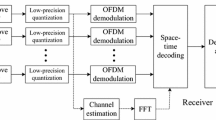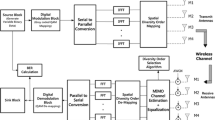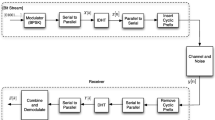Abstract
In the rapidly time-varying channel environment, the performance of traditional MIMO-OFDM system is deteriorated due to the intercarrier interference. In this paper, a novel MIMO-OFDM system is proposed, in which the modulation and demodulation of the symbols are implemented by the fractional Fourier transform instead of traditional Fourier transform. Through selecting the optimal order of the fractional Fourier transform, the modulated signals can match the time-varying channel characteristics, which results in a mitigation of the intercarrier interference. Furthermore, an algorithm is presented for selecting the optimal order of fractional Fourier transform, and the impact of system parameters on the optimal order is analyzed. Simulation results show that the proposed system can concentrate the power of desired signal effectively and improve the performance over rapidly time-varying channels with respect to the traditional MIMO-OFDM system.
Similar content being viewed by others
References
Foschini G J, Gans M J. On limits of wireless communication in a fading environment when using multiple antennas. Wirel Pers Commun, 1998, 6(3): 311–335
Jankiraman M. Space-Time Codes and MIMO Systems. Boston-London: Artech House Publishers, 2004. 1–12
Wang Z, Giannakis G B. Wireless multicarrier communications: where Fourier meets Shannon. IEEE Signal Process Mag, 2000, 17(3): 29–48
Stuber G L, Barry J R, McLaughlin S W, et al. Broadband MIMO-OFDM Wireless Communications. Proc IEEE, 2004, 92(2): 271–294
Stamoulis A, Diggavi S N Al-Dhahir N. Intercarrier Interference in MIMO OFDM. IEEE Trans Signal Process, 2002, 50(10): 2451–2464
Song L J, Mohsen K. Effects of time selective multipath fading on OFDM systems for broadband mobile application. IEEE Commun Lett, 1999, 3(12): 332–334
Vahlin A, Holte N. Optimal finite duration pulses for OFDM. IEEE Trans Commun, 1996, 44(1): 10–14
Kozek W, Molisch A. Nonorthogonal pulseshapes for multicarrier communications in doubly dispersive channels. IEEE J Sel Area Commun, 1998, 16(8): 1579–1589
Strohmer T, Beaver S. Optimal OFDM design for time-frequency dispersive channels. IEEE Trans Commun, 2003, 51(7): 1111–1122
Martone M. A multicarrier system based on the fractional Fourier transform for time-frequency selective channels. IEEE Trans Commun, 2001, 49(6): 1011–1020
Almeida L B. The fractional Fourier transform and time-frequency representations. IEEE Trans Signal Process, 1994, 42(11): 3084–3091
Ozaktas H M, Zalevsky Z, Kutay M A. The Fractional Fourier Transform with Applications in Optics and Signal Processing. New York: Wiley, 2000. 319–464
Lohmann A W. Image rotation, Wigner rotation, and the fractional Fourier transform. J Opt Soc Amer A, 1993, 10: 2181–2186
Ozaktas H M, Barshan B, Mendlovic D, et al. Convolution, filtering, and multiplexing in fractional Fourier domains and their relationship to chirp and wavelet transform. J Opt Soc Amer A, 1994, 11: 547–559
Tao R, Deng B, Wang Y. Research progress of the fractional Fourier in signal processing. Sci China Ser F-Inf Sci, 2006, 49(1): 1–25
Tao R, Qi L, Wang Y. Theory and Application of the Fractional Fourier Transform (in Chinese). Beijing: Tsinghua University Press, 2004. 111–175
Ozaktas H M, Arikan O, Kutay M A, et al. Digital computation of the fractional Fourier transform. IEEE Trans on Signal Process, 1996, 44(9): 2141–2150
Pei S C, Ding J J. Closed-form discrete fractional and affine Fourier transforms. IEEE Trans Signal Process, 2000, 48(5): 1338–1353
Santhanam B, McClellan J H. The discrete rotational Fourier transform. IEEE Trans Signal Process, 1996, 42: 994–998
Kraniauskas P, Cariolaro G, Erseghe T. Method for defining a class of fractional operations. IEEE Trans Signal Process, 1998, 46: 2804–2807
Deng X G, Li Y P, Fan D Y, et al. A fast algorithm for fractional Fourier transforms. Opt Commun, 1997, 138: 270–274
Pei S C, Yeh M H. Discrete fractional Fourier transform. In: Proc IEEE Int Symp Circ Syst. Washington: IEEE, 1996. 536–539
Pei S C, Yeh M H. Improved discrete fractional Fourier transform. Opt Lett, 1997, 22: 1047–1049
Chen E Q. Research on the key techniques for the OFDM system based on the fractional Fourier transform. Doctoral Dissertation. Beijing: Beijing Institute of Technology, 2006. 39–40
Moose H. A technique for orthogonal frequency-division multiplexing frequency offset correction. IEEE Trans Commun, 1994, 42(10): 2908–2914
Zhang Y, Liu H P. Impact of time-selective fading on the performance of quasi-orthogonal space-time-coded OFDM systems. IEEE Trans Commun, 2006, 54(2): 251–260
Pop M F, Norman C. Beaulieu. limitations of sum-of-sinusoids fading channel simulators. IEEE Trans Commun, 2001, 49(4): 699–708
Author information
Authors and Affiliations
Corresponding author
Rights and permissions
About this article
Cite this article
Yang, Q., Tao, R., Wang, Y. et al. MIMO-OFDM system based on fractional Fourier transform and selecting algorithm for optimal order. Sci. China Ser. F-Inf. Sci. 51, 1360–1371 (2008). https://doi.org/10.1007/s11432-008-0123-0
Received:
Accepted:
Published:
Issue Date:
DOI: https://doi.org/10.1007/s11432-008-0123-0




